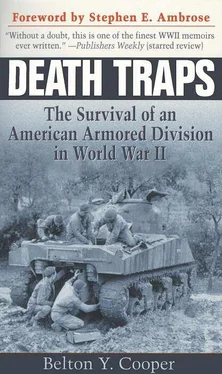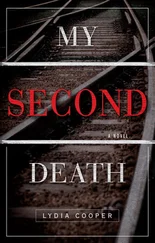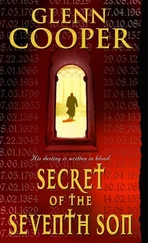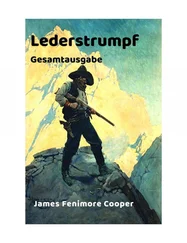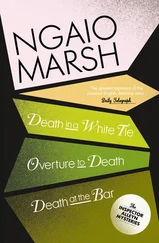In order to carry out this job effectively, it was necessary for the maintenance companies to operate in extremely far forward positions with the combat commands. These maintenance companies were responsible for their own security because of the fact that often they would have to drop off crews and set up VCP’s (vehicle collection points) after the combat command had moved on. Each maintenance company had three 57mm antitank guns for its own protection. These antitank guns were manned by maintenance personnel who had been trained by the main antitank section back in the headquarters company. These forward maintenance elements not only took care of our combat command, but often did maintenance for the various infantry divisions attached to the corps. These infantry units had no forward maintenance, and would have been completely helpless without the vehicles and weapons maintained by the forward maintenance units in the combat command.
Thus it may be seen that the VII Corps, which was the most powerful armored corps in the First Army, which in turn made it the most powerful armor corps in Western Europe, depended heavily on the forward maintenance of the 3d Armored Division, and without this help they would not have been able to accomplish many of their remarkable long movements and envelopments. Herein lies a third major focus of this book.
All personal memoirs of the war are written from the author’s perspective. As my perspective was a relatively limited one, I feel this should be explained in the beginning.
Before entering combat, and as part of my training as an Ordnance Officer, I attended the Armored Force School at Ft. Knox. This not only provided me with a practical background in tank and vehicular maintenance, but also provided me with a theoretical background in armored war tactics. This knowledge of American Armored Force Doctrine proved particularly valuable later in combat, and gave me an appreciation of how German armored superiority forced American tank commanders to disregard doctrine and improvise new tactical solutions.
There were sixteen armored divisions in the American army during World War II. Out of this number, only the 2d and 3d remained heavy armored divisions. Later combat experience proved that the heavy armored divisions could sustain much heavier losses than the light ones, and thus be more effective in major operations. For this reason, the 2d and 3d Armored Divisions teamed up and worked side by side in every major operation from Normandy to the end of the war in Europe.
As the spearhead of the First Army in all these major operations, the 3d Armored Division destroyed more German tanks, inflicted greater enemy losses, and participated in the capture of more prisoners than any other American armored division. In accomplishing this distinction, the 3d Armored Division lost more American tanks than any other American armored division. Of the three combat commands in the 3d Armored Division, Combat Command B destroyed more German tanks and lost more American tanks than any other combat command. As the ordnance liaison officer for Combat Command B of the 3d Armored Division, I believe I have seen more battle damaged American tanks than any other living American.
After each fire fight, the maintenance group would go forward and try to locate the damaged vehicles. Unless we could locate the knocked out tank by its map coordinates and at the same time get the “W” number on the tank as well as determine the extent of the damage, it was difficult to obtain a replacement tank through the military supply bureaucracy.
Once the extent of damage to a vehicle had been determined, a quick decision was made whether it could be repaired by the combat maintenance facilities, or whether it would have to be left for the army ordnance depot to pick up later. In this latter event, a request could be made for a replacement vehicle. If the tank was in a mine field, we would have to get the engineers to come up and clear a path, in order for recovery vehicles to get to it. If not, we could make immediate plans to evacuate the tank to a VCP.
In preparing combat loss reports day after day, I became intimately familiar with weaknesses and inadequacy of our main battle tank, the M4 Sherman. I also learned about the weapons and tactics the Germans used to knock out our tanks.
After dark, it was my responsibility to carry the combat loss report to the division maintenance battalion headquarters located some thirty to fifty miles to the rear. Because the information in this report would have been extremely beneficial to the enemy, should it have fallen into their hands, it could not be sent by radio, but instead had to be carried by personal messenger.
I put the report and other sensitive documents in a small plywood box, which was located in the back seat of my Jeep. I also kept a thermite incendiary grenade inside the box. In the event of ambush the plan was to set off the grenade and abandon the Jeep in hope that the documents would be burned up and destroyed.
The area between the combat command columns and the division trains was known as the “void,” and travelling through the void was called “running the gauntlet.” During the day, an armored division combat command would bypass many enemy units. Since the American infantry units following the combat command would sometimes not come forward for a day or more, there were probably no friendly units between the combat command and the division rear. It was logical to assume that any units we met on the road at night would probably be German.
Thus, it was necessary to travel with extreme caution. We could not even use our blackout lights or flashlight to look at a map. It was necessary to memorize the road junctions with the map as we came forward during the day.
My driver and I would generally leave the combat command VCP after midnight. The windshield of our Jeep was lowered flat against the hood and covered with a canvas cover to protect against reflection of flares or moonlight. We did have a small angle iron wire cutter mounted on the bumper. This was protection against wires which the Germans would sometimes run across the road to decapitate Americans riding in jeeps or motorcycles.
We worked out a technique by which we could travel with a reasonable degree of safety. In Europe, most of the highways had trees growing on both sides of the road, and at night there was a discernible amount of starlight shining between the trees, even if it was cloudy. My driver would look up at an angle of approximately 30 degrees, and I would look straight down the highway to discern any remote objects, or possible German roadblocks, as far away as possible. We were able to stay fairly well in the center of the road, and drove at a top speed of sixty-five miles per hour, which was as fast as the Jeep would go.
When we arrived at the division maintenance battalion headquarters I would report to the maintenance battalion shop officer and give him the combat loss report. I would give him all of the information I knew on the tactical situation as well as the location of the knocked out tanks and other vehicles. Although the vehicles being replaced were actually those that had been destroyed two days before, the fact that we brought fresh vehicles every twenty-five hours enabled the Combat Command to maintain a reasonable degree of its combat strength.
In order to travel the thirty to fifty miles between the Combat Command and the division maintenance battalion headquarters in the dark of night, I needed to know my location in both terms of map coordinates and my positional relationship to other American units. In order to lead the replacement tank convoy back to the Combat Command, I had to know not only where I was going, but also where the Combat Command was going. I, therefore, had to know more about the overall tactical situation facing the division than most junior officers.
Читать дальше
